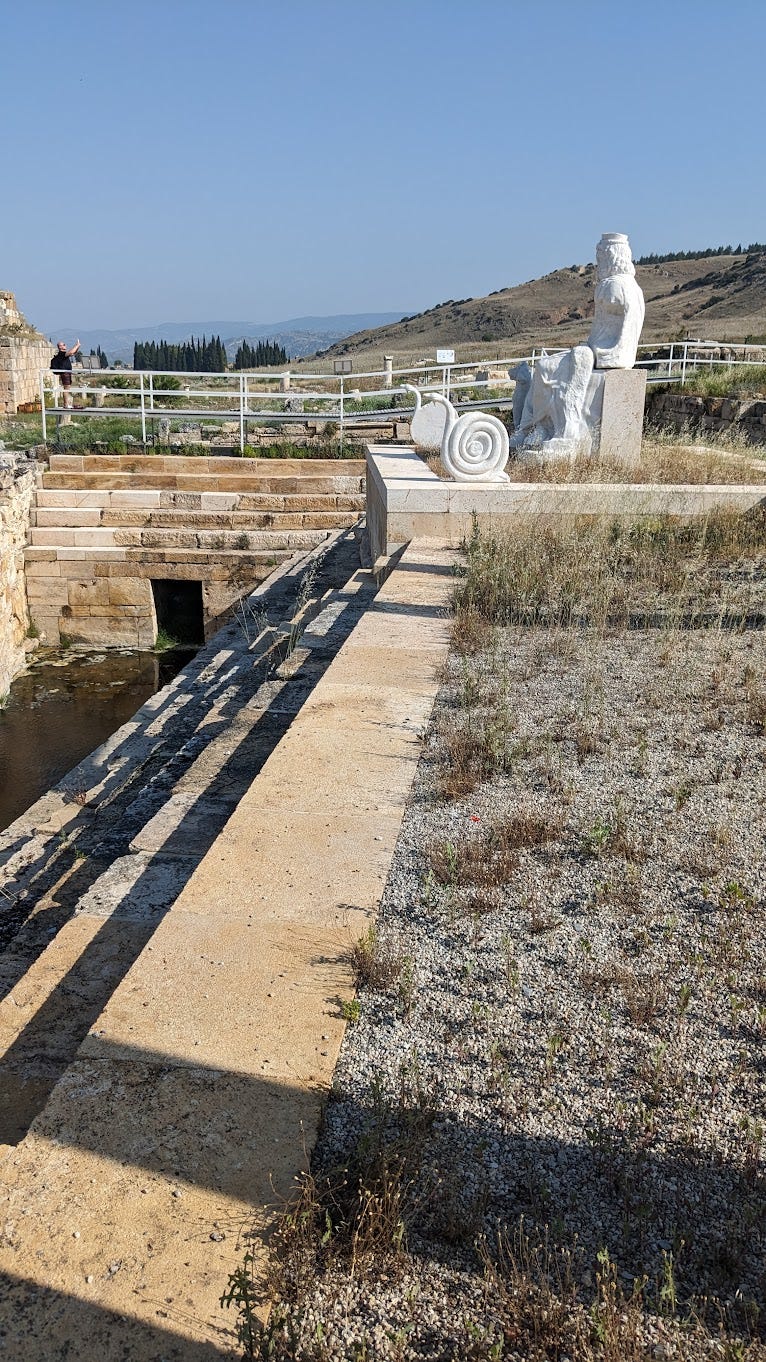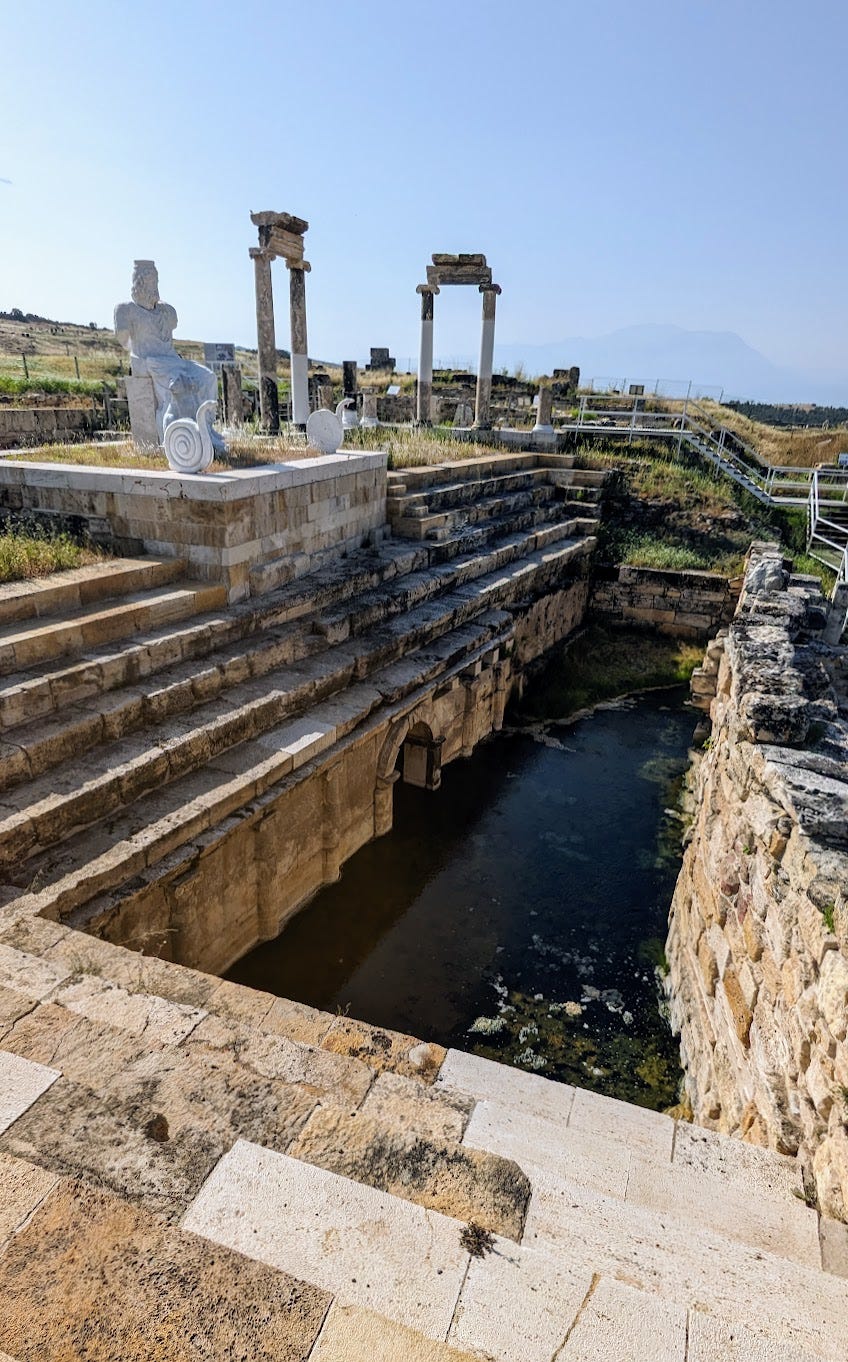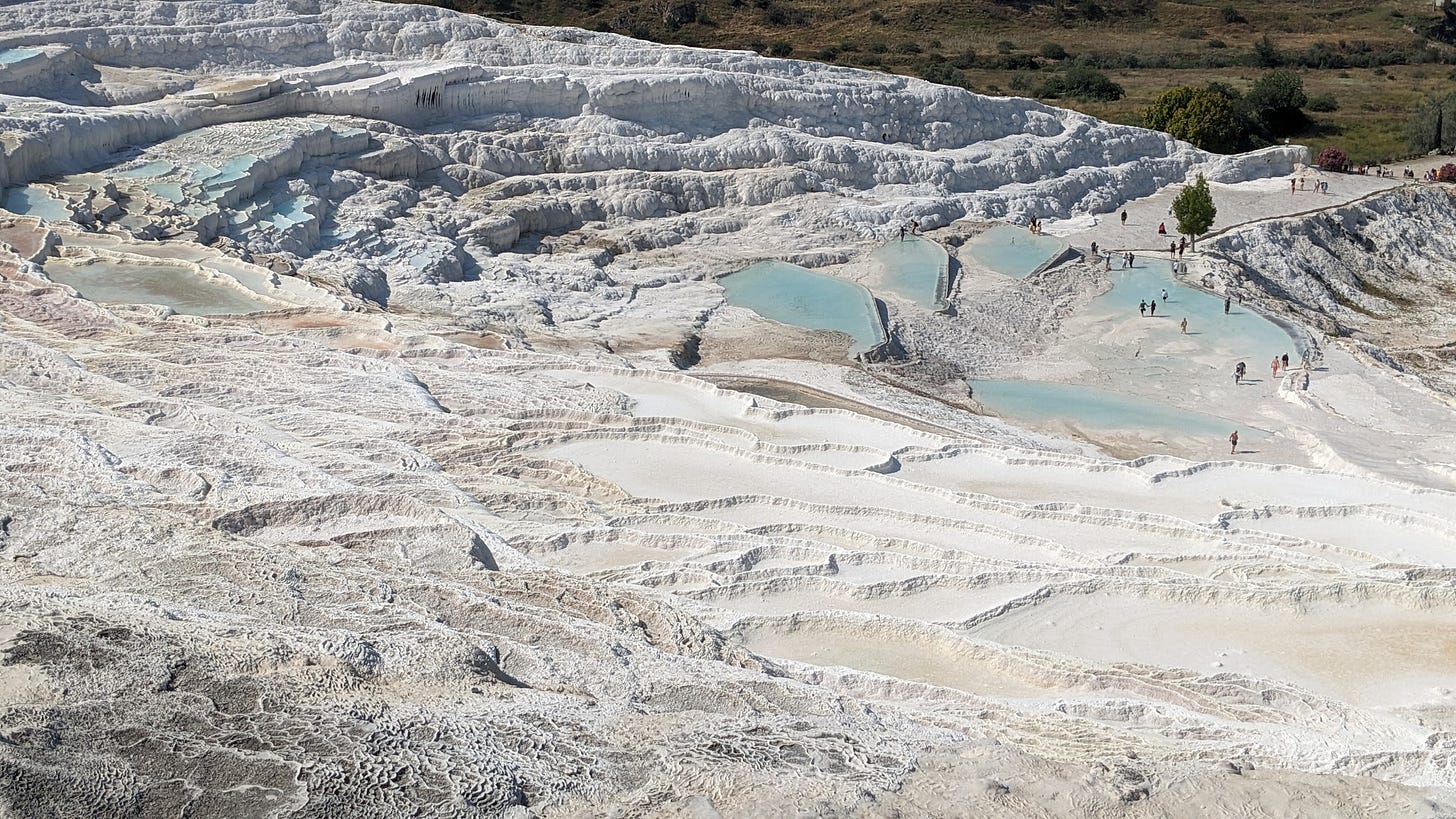I once had a vision of the beginning of the world. I was on an early morning walk along the Firehole River in Yellowstone National Park. I looked up at the cliffs across the canyon, and I saw rock twisted and contorted into desperate spirals, magma that was frozen in the moment of creation of the landscape through which I wandered.
Creation was no easy thing, I surmised. It was an act of fire and destruction, an act which shuddered mountains to fine dust, exploded mountains from the seas, and twisted granite like a toddler forms Play-Doh.
When I visit Pamukkale, one of Türkiye’s most amazing natural wonders, I often think of Yellowstone and the window on creation I witnessed there. Because the idea of death and destruction, left here by nature millions of years before mankind, has haunted the place from its earliest human history to the present day.
The Geology of Pamukkale
The most arresting area of this charming town, where hot air balloons rise among the vast farms of the Cürüskü Plain, is the round, white terraces that lead in blue-pooled terraces to the top of an 200m-high escarpment above the town of 2,500.
Pamuk in Turkish means “cotton,” and kale means “castle.” And the locals call their lovely cliffs the “8th Wonder of the World.” (Speaking of wonders of the world, Pamukkale lies about 3 hours’ drive from Ephesus, home of one of the first seven.)
How did Pamukkale become a “cotton castle”? It’s a fascinating tale. During the Mesozoic Era, seas covered the area, and a thick layer of limestone built up, adding the minerals that bubble out of the ground and cling to the cliffs to this very day.
After the end of the Mesozoic 66 million years ago, tectonic activity raised the escarpment above the current site of the city, and closer to our own era, near the beginning of the Quaternary Period, some 5-6 million years ago, Mount Horaz erupted 40 km away, leaving igneous rock scattered throughout the highlands above the plain and bringing magma close to the crust where hydrothermal activity continues to this very day.
The water that bubbles to the surface at the top of the cliffs is boiling at 100℃ in some places. At “Cleopatra’s Pool,” a spectacular place to swim in mineral-choked waters among Roman columns, the water is 35℃ year-around.
The water carries many minerals, which is why the city atop the cliffs, Hierapolis, served as a health spa from historic times to the present. A guide explained to me that Cleopatra’s Pool has sulphur, among many other minerals, and bathers found healing for skin and muscle conditions after extended stays.
The mineral that is key to the cotton cliffs is calcium carbonate (CaCO3), which bubbles up from the limestone along with the water that carries it. The water cools as it flows down the cliffs, releasing oxygen and carbon dioxide. Atoms of white calcium cling to the rock and build up deposits of travertine.

(Travertine steps like those in Pamukkale can be found in the United States at Mammoth Hot Springs in Yellowstone National Park, as well as Plitvice Lakes National Park in Croatia. But what is really fascinating to me were the famous monuments built from travertine blocks: the Colosseum in Rome, and the Sacre-Couer Basilica in Paris (pictured,from Natural Stone Online). Milk-white, travertine tiles cover modern buildings such as the Shell-Haus in Berlin and the Getty Center in Los Angeles.)
On the walk up the ramp from Pamukkale to the top of the cliffs, visitors pass two, larger, rectangular pools along the cliffs, shaped quite differently from the rounded terraces that make up the steps. These pools were artificial, their sides made from concrete blocks in the 1970s. Yet the blocks are covered with white, with frozen waterfalls flowing from their sides. Such is the rate of build-up
The web site Industrial Engineering has a fascinating breakdown of the rate at which the travertine forms. A liter of water that bubbles out of the top of the escarpment will lose 580 mg of CO2, 200 mg of Calcium, and 1 g of calcium carbonate in its journey to the base of the cliffs. This adds 41.2 kg of calcium carbonate to the cliffs every day, enough to cover almost 5 square kilometers to a depth of 1 mm every day.
The Temple of Hades, Hierapolis
About 150 meters from the edge of the escarpment, a rift clefts the mesa. In the ancient city of Hierapolis, built around this rift – the city proper on one side, Cleopatra’s Pool and the cliff-top spas on the other – the buildings astride this cleft in the ground made up Temple Row.
The temple to Apollo was built above this cleft and replaced the temple of an earlier, local god, which held an oracle who would breathe in the vapors emitting from a cleft in the rock. She would mumble a few words to a waiting priest who would, in turn, write a vague prophecy for the paying visitors. The geology created the carbon dioxide and sulphur gasses, the temples turned them into a draw for pilgrims and travelers seeking physical and spiritual healing.
A little ways past the Apollo Temple but lying along the same fault lies my favorite site in Hierapolis: the Temple of Hades, also known as The Plutonium. (Hades’s Roman name was Pluto, it has nothing to do with the element.) Archaeologists restoring the site have added a copy of a statue of Hades found there, flanked by huge serpents and guarded by the three-headed dog, Cerberus, to the temple site.

The statue and temple columns overlook a deep, square pit with steps leading down to a pool on three sides. On the fourth side is a tunnel that leads directly under the statue of Hades. This tunnel was known in ancient times as one of the entrances to the Underworld. No wonder a temple of Hades and a statue of Cerberus would guard the door.

The steps of the sunken chamber were used as seating for a remarkable ceremony. The cave that led under the temple was filled with carbon dioxide. Any animal that entered the cave would suffocate and die for a lack of oxygen. Sacrificial victims were led into the cave under the watchful eyes of worshippers seated on the steps. (Accounts claim that the priests of Hades knew to hold their breaths.) The victim would drop dead in the cave and be brought out with no sign of violence or blood. It must have left a powerful impression on onlookers.
There are more places on the Way of Death in Hierapolis to share. Next week, I will share what I learned at the Martirum of St. Philip and at the city’s two necropoli.



